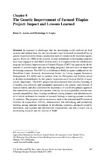The genetic improvement of farmed tilapias project: Impact and lessons learned
Share
စိတ္တဇ
In response to challenges that the developing world confront on food security and malnutrition, the last two decades have witnessed increased efforts in genetic improvement to enhance production traits of commercially important aquatic species. From the 1980s to the present, several institutions in developing countries have been engaged in such R&D activity and it is recognized that the collaborative program on Genetic Improvement of Farmed Tilapias (GIFT) has spurred the development of several tilapia and carp breeding programs that now exist in numerous developing countries. The GIFT is a collaborative R&D program conducted by the WorldFish Center (formerly, International Center for Living Aquatic Resources Management, ICLARM) and its partners from the Philippines and Norway aimed to develop methodologies for the genetic improvement of tropical finfish of aqua-culture importance. The GIFT project has demonstrated that selective breeding is a feasible, cost effective, and sustainable approach to the genetic improvement of tropical finfish, and also confirmed the importance of a multidisciplinary approach that enabled the assessment of economic viability, social acceptability, and environmental compatibility, thus, creating confidence among planners and administrators, all of which facilitated the transfer of research findings to farming systems in a host of countries. The program and its successors, such as the International Network on Genetics in Aquaculture (INGA), demonstrated that networking and partnership building among national institutions in developing countries, advanced scientific institutions, and regional and international organizations can play a major role in accelerating research and the success of R&D.
Suggested Citation
Acosta, B. O., & Gupta, M. V. (2010). The genetic improvement of farmed tilapias project: Impact and lessons learned. In S. S. Silva & F. B. Davy (Eds.), Success Stories in Asian Aquaculture (pp. 149-171). Dordrecht: Springer Netherlands.


